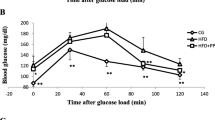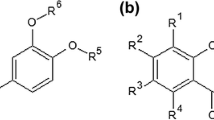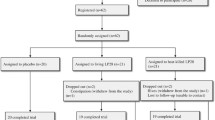Abstract
Objective:
To investigate the anti-obesity effects of the pomegranate leaf extract (PLE) in a mouse model of high-fat diet induced obesity and hyperlipidemia.
Design:
For the anti-obesity experiment, male and female ICR mice were fed with a high-fat diet to induce obesity. When the weight of the high-fat diet group was 20% higher than the normal diet group, the animals were treated with 400 or 800 mg/kg/day of PLE for 5 weeks. Body weight and daily food intake were measured regularly during the experimental period. The various adipose pads were weighed and serum total cholesterol (TC), triglyceride (TG), glucose and high-density lipoprotein cholesterol (HDL-C) were measured after 5 weeks, treatment with PLE. In the fat absorption experiment, both the normal and obese mice were given 0.5 ml lipid emulsion and PLE at a dose of 800 mg/kg at the same time. Serial serum TG levels were measured at times 1, 2, 3, 4 and 6 h after the treatment. TGs in fecal excretions were measured after the mice were orally given a lipid emulsion. Effects of PLE and its isolated compounds (ellagic acid and tannic acid) on pancreatic lipase activity were examined in vitro.
Results:
The PLE-treated groups showed a significant decrease in body weight, energy intake and various adipose pad weight percents and serum, TC, TG, glucose levels and TC/HDL-C ratio after 5 weeks treatment. Furthermore, PLE significantly attenuated the raising of the serum TG level and inhibited the intestinal fat absorption in mice given a fat emulsion orally. PLE showed a significant difference in decreasing the appetite of obese mice fed a high-fat diet, but showed no effect in mice fed a normal diet.
Conclusion:
PLE can inhibit the development of obesity and hyperlipidemia in high-fat diet induced obese mice. The effects appear to be partly mediated by inhibiting the pancreatic lipase activity and suppressing energy intake. PLE may be a novel appetite suppressant that only affects obesity owing to a high-fat diet.



Similar content being viewed by others
References
Allan JD . Rampant obesity: what you can do? Sexuality, Reproduction and Menopause 2004; 2: 195–198.
Paccaud F, Schiuter-Fasmeyer V, Wietlisbach V, Bovet P . Dyslipidemia and abdominal obesity: an assessment in three general populations. J Clin Epid 2000; 53: 393–400.
Rebuffe-Scrive M, Surwit R, Feinglos M, Kuhn C, Rodin J . Regional fat distribution and metabolism in a new mouse model (C57BL/6J) of non-insulin-dependent diabetes mellitus. Metabolism 1993; 42: 1405–1409.
Surwit RS, Kuhn CM, Cochrane C, McCubbin JA, Feinglos MN . Diet-induced type II diabetes in C57BL/6J mice. Diabetes 1988; 37: 1163–1167.
Widdowson PS, Upton R, Buckingham R, Arch J, Williams G . Inhibition of food response to intracerebroventricular injection of leptin is attenuated in rats with diet-induced obesity. Diabetes 1997; 46: 1782–1785.
Storlien LH, James DE, Burleigh KM, Chisholm DJ, Kraegen EW . Fat feeding causes widespread in vivo insulin resistance, decreased energy expenditure, and obesity in rats. Am J Physiol 1986; 251 (5 Part 1): E576–E583.
Ajaikumar KB, Asheef M, Babu BH, Padikkala J . The inhibition of gastric mucosal injury by Punicagranatum L. (pomegranate) methanolic extract. J Ethnopharmacol 2005; 96: 171–176.
Murthy KN, Reddy VK, Veigas JM, Murthy UD . Study on wound healing activity of Punica granatum peel. J Med Food 2004; 7: 256–259.
Braga LC, Shupp JW, Cummings C, Jett M, Jett M, Takahashi JA et al. Pomegranate extract inhibits Staphylococcus aureus growth and subsequent enterotoxin production. J Ethnopharmacol 2005; 96: 335–339.
Chidambara Murthy KN, Jayaprakasha GK, Singh RP . Studies on antioxidant activity of pomegranate (Punica granatum) peel extract using in vivo models. J Agric Food Chem 2002; 50: 4791–4795.
Hora JJ, Maydew ER, Lansky EP, Dwivedi C . Chemopreventive effects of pomegranate seed oil on skin tumor development in CD1 mice. J Med Food 2003; 6: 157–161.
Kohno H, Suzuki R, Yasui Y, Hosokawa M, Miyashita K, Tanaka T . Pomegranate seed oil rich in conjugated linolenic acid suppresses chemically induced colon carcinogenesis in rats. Cancer Sci 2004; 95: 481–486.
Afaq F, Saleem M, Krueger CG, Reed JD, Mukhtar H . Anthocyanin- and hydrolyzable tannin-rich pomegranate fruit extract modulates MAPK and NF-kappaB pathways and inhibits skin tumorigenesis in CD-1 mice. Int J Cancer 2005; 113: 423–433.
Wang RF, Xie WD, Zhang Z, Xing DM, Ding Y, Wang W et al. Bioactive compounds from the seeds of Punica granatum (pomegranate). J Nat Prod 2004; 67: 2096–2098.
Kaplan M, Hayek T, Raz A, Coleman R, Dornfeld L, Vaya J et al. Pomegranate juice supplementation to atherosclerotic mice reduces macrophage lipid peroxidation, cellular cholesterol accumulation and development of atherosclerosis. J Nutr 2001; 131: 2082–2089.
Huang TH, Peng G, Kota BP, Li GQ, Yamahara J, Roufogalis BD et al. Pomegranate flower improves cardiac lipid metabolism in a diabetic rat model: role of lowering circulating lipids. Br J Pharmacol 2005; 145: 767–774.
Astrup A, Toubro S, Raben A, Skov AR . The role of low-fat diets and fat substitutes in body weight management: what have we learned from clinical studies? J Am Diet Assoc 1997; 97 (Suppl): S82–S87.
Van DE, Kamer JH, Ten Bokkel H, Weyers HA . Rapid method for the determination of fat in feces. J Biol Chem 1949; 177: 347–355.
Han LK, Kimura Y, Kawashima M, Takaku T, Taniyama T, Hayashi T et al. Anti-obesity effects in rodents of dietary teasaponin, a lipase inhibitor. Int J Obes Relat Metab Disord 2001; 25: 1459–1464.
Lowe ME . Pancreatic triglyceride lipase and colipase: insights into dietary fat digestion. Gastroenterology 1994; 107: 1524–1536.
Drent ML, Van der Veen EA . First clinical studies with Orlistat: a short review. Obes Res 1995; 3 (Suppl 4): 623s–625s.
Acknowledgements
The study was supported by Natural Science Foundation of China (30572340).
Author information
Authors and Affiliations
Corresponding author
Rights and permissions
About this article
Cite this article
Lei, F., Zhang, X., Wang, W. et al. Evidence of anti-obesity effects of the pomegranate leaf extract in high-fat diet induced obese mice. Int J Obes 31, 1023–1029 (2007). https://doi.org/10.1038/sj.ijo.0803502
Received:
Revised:
Accepted:
Published:
Issue Date:
DOI: https://doi.org/10.1038/sj.ijo.0803502
- Springer Nature Limited
Keywords
This article is cited by
-
Molecular hybridization method for obtaining paeonol-based fibrate derivatives with potent lipid-lowering and hepatoprotective activity
Medicinal Chemistry Research (2024)
-
Vitamin D3 supplementation shapes the composition of gut microbiota and improves some obesity parameters induced by high-fat diet in mice
European Journal of Nutrition (2024)
-
A comprehensive review on phytochemistry, bioactivity and medicinal value of bioactive compounds of pomegranate (Punica granatum)
Advances in Traditional Medicine (2023)
-
Pomegranate juice intake enhances the effects of aerobic training on insulin resistance and liver enzymes in type 2 diabetic men: a single-blind controlled trial
BMC Nutrition (2022)
-
Pomegranate peel anthocyanins prevent diet-induced obesity and insulin resistance in association with modulation of the gut microbiota in mice
European Journal of Nutrition (2022)




